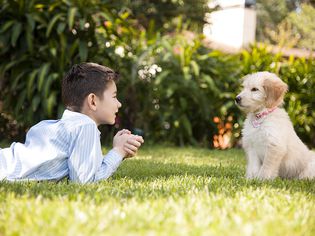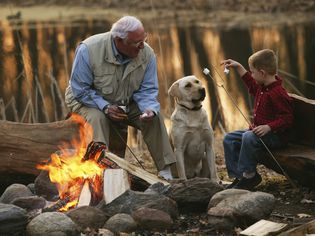Dogs are social creatures that live together, and so they need a dog language in order to get along. How dogs communicate with one another is based on a system of common signals. Obviously, dogs can't talk, so their "language" is comprised of other signals—primarily body language, such as movement and positioning of the ears and tail, as well as how a dog positions himself near other dogs.
Your dog's ancestors survived by forming packs that hunted together, communally protected young, and defended territory from outsiders. And while two individuals can get along, the more individuals added to a group increase the chance of arguments. Constant fights and injuries weaken the group. Survival depends on every dog—and puppy—in the group staying healthy and productive.
Dog language not only allows dogs to communicate and understand each other. It also is a system used for conflict resolution, including calming signals that head off fights. In fact, once you understand how dogs communicate and the way they interpret your verbal and silent body language, you can better communicate with your puppy.
How Dogs Communicate
Canine communication is a complex system of body language, vocalization, and even scent cues. These signals reinforce the dog's social position within the group.
Dogs are pretty flexible with members of their family group. That’s why it’s so important to socialize your puppy early and continue throughout his or her life. Your dog considers you—and other people and pets in the household—to be a part of his family group, and acts accordingly.
Why It Matters
Many behavior problems arise from normal dog behaviors such as chewing, barking, and more. Oftentimes, though we think we are being clear by directing and vocalizing to our pets: we are actually are not communicating in a way that our dog can understand. Even though your communication to your pet seems obvious to you, it is often as if trying to understand a foreign language to a dog. They can only interpret the best way they know-how.
If your relationship is to reach its full potential, it is important that you understand how your dog communicates so that you can be more effective at teaching him. Don’t expect puppies (or adult dogs for that matter) to automatically understand and read your mind. Puppies make behavior mistakes because they don’t know any better and more often than not it's a communication failure on our side! Participating in puppy training classes and working with certified dog trainers from an early age can be very helpful.
Types
Compared to your puppy, humans are hearing-deaf and scent-blind. That makes it impossible for us to understand some of the more subtle signals of the canine language. But by paying close attention to body language and apparent vocal cues that our pets give us, we can learn to interpret the more obvious canine signals.
Dogs evolved with the ability and fascination of paying close attention to the humans they love. So your puppy will meet you halfway, given a chance, and learn a large human vocabulary, particularly when words and tone and training efforts are used with consistency.
Dogs use body language, vocalizations, and scent alone or in combination. Each type of communication has advantages and disadvantages.
Body language is one of the main ways that pets communicate and it can be so subtle that even an experienced dog owner can miss cues from time to time. Being aware of the eye, ear, tail, and body movement and positioning and the various meanings are very important for understanding your pet.
Though it seems subtle, body language is one of the few ways dogs have of communicating with us! Dogs have spent centuries trying to understand humans so as to please them. We could do a lot more to try to understand them. The more time you spend with your pet socializing, going for walks, working with certified trainer's and purposely paying attention to their body language, the better you will get. The best dog owners are consistent with this.
Sound carries over long distances. Howls, barks, yips, snarls, and growls are more easily understood amongst dogs. However, a bark may alert adversaries as well as pack members, so it’s not effective for stealth communication. Barks can communicate a lot of different messages such as excitement, fear, need for food or water, and more.
Scent signals don’t require the dog’s presence to get a message across. The scent of urination can be left behind to alert other dogs of their presence. Anal gland scents can be left when a dog defecates which is normal or in instances when a dog is extremely nervous or fearful, anal glands may be expressed leaving a lingering odor.
Dogs use combinations of each technique to communicate meaning. Very basically, canine communication is used to either decrease the distance between individuals with signals that ask for attention—a wagging puppy tail, for example—or to increase the distance between individuals with warning signals such as growls.









Comments on " Understanding Dog Talk" :